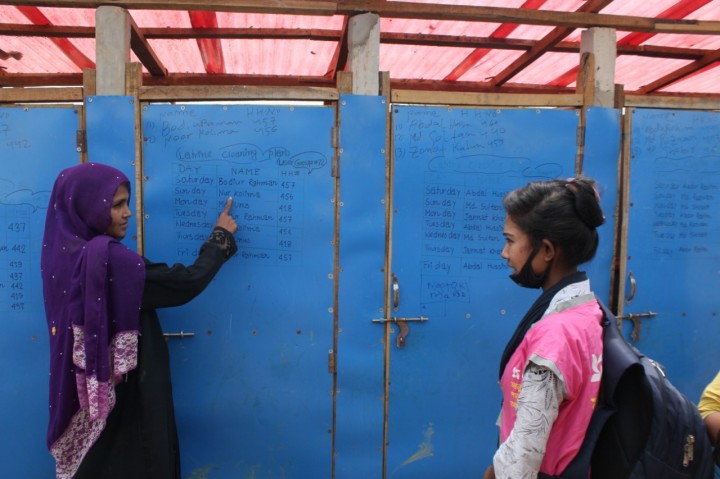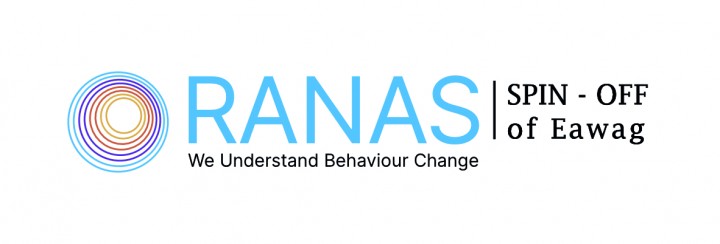Evaluated behaviour change interventions for WaSH & environmental improvements in the Rohingya refugee response, Bangladesh A pilot project in the refugee camps aimed to enhance behaviour change in Rohingya communities through systematic behaviour change interventions. The interventions were tailored to the assessed behavioural drivers of the Rohingya communities and proven to
Ranas Ltd.
Ranas
Assess current practices and the behavioural factors determining these practices (12 different WASH behaviours). Design, implement, and evaluate systematic behaviour change strategies to promote safe behaviours.

Mission
The main goal of this project was to promote the following hygienic and environmental behaviours: child faeces disposal, cleaning water utensils, drinking chlorinated water, handwashing with soap, cleaning shared latrines, menstrual hygiene management, not-littering, open defecation, safe water collection, waste segregation and water storage. Specific objectives were: • To assess current practices and the behavioural factors determining these practices. • To design, implement, and evaluate systematic behaviour change strategies to promote safe behaviours.Approach
In the context of the Rohingya refugee communities located in Cox’s Bazar, Bangladesh, RANAS Ltd. realized a pilot project led by UNICEF, and partially funded by SDC, to improve hygiene promotion activities of nine different WASH sector partners. The partners selected a broad set of 11 different health and environmental protective behaviours. The pilot project was implemented during August 2019 until end of 2020, with the Corona pandemic interfering strongly with the intended timeline. Due to the restrictions related to Covid-19, only 7 out of 11 behaviours were assessed in the final evaluation. According to the RANAS approach the following steps were conducted. RANAS Steps 1 & 2: Identify, measure, and determine behavioural factors of handwashing: • Qualitative research was conducted in 120 interviews to identify potential behavioural factors. • A quantitative baseline survey on all mentioned practices and behavioural determinants was conducted in 400 face-to-face interviews per target behaviour in June to August, 2019 (total of 5000 interviews). • The behavioural factors influencing target behaviours were specified by comparing the answers of the doers and non-doers. Factors were identified for each target behaviour that differ between doers (people who already show the “safe” behaviour) and non-doers (people who do not yet show the “safe” behaviour). • Example for handwashing with soap: Health knowledge, Feelings, Social norms, Personal importance, Confidence in performance, Action and Barrier planning, Commitment. Based on the behavioural factors identified with the doer/non-doer analysis, behaviour change techniques (BCTs) were selected from the RANAS catalogue of BCTs. Together with our local partner, a contextualized behaviour change campaign was developed with the following elements (RANAS phase 3): Example for latrine cleaning: ‘Present facts’ and ‘Prompt to talk to others’ as well as ‘Describe feelings about positive consequences’ were delivered through user group meetings, where doers talked to non-doers. In the same meetings, health promoters let people demonstrate latrine cleaning (‘Prompt behavioural practice’) and helped the user group develop detailed cleaning action plans (‘Prompt specific planning’), as well as discussed solutions to possible challenges (‘Prompt coping with barriers’). The user group ‘Agreed on a behavioural contract’. Through household visits, ‘Inform about other’s behaviour’ and ‘others’ approval’ and ‘Prompt identification as a role model’ was realized. Our partners implemented the campaigns and we evaluated the behaviour change (RANAS phase 4): The interventions’ effectiveness was assessed through a before-after trial and compared to a control group with a standard approach. The behaviour change interventions were implemented in the target blocks of the refugee camp by the local partners. The interventions were compared to other camp blocks were a standard intervention was implemented. The final follow-up survey on seven target behaviours, behavioural determinants and the interventions’ evaluation was conducted in 900 households in October 2020. Latrine cleaning: Increase of 21% of people cleaning their latrines on a regular basis. 65% of respondents report to have a detailed action plan for latrine cleaning Access to latrines increased significantly by 36% Compared to the standard intervention, the RANAS intervention group was more successful in achieving behaviour change. This was because they successfully changed the key behavioural factors of latrine cleaning, especially negative feelings related to latrine cleaning, confidence in performance and active action and barrier plans. Other behaviours: Menstrual hygiene management: Increase in intention and habit to wash and dry menstrual cloths properly. Increase in access to private spaces for menstrual hygiene management. Achieved through positive changes on related behavioural factors, such as positive feelings and beliefs in benefits of clean and dry menstrual cloths. Handwashing with soap: compared to baseline, 15% increase in regular handwashing and strong increase in frequency of handwashing with soap. Changes in behavioural factors, such as increase in remembering of handwashing. Drinking chlorinated water: 45% increase of participants using chlorinated water. Achieved through changes on behavioural factors, such as positive feelings and beliefs in costs and benefits, as well as others’ behaviour and confidence in performance. Conclusion: To increase effectiveness, behaviour change interventions should be based on theory and driven by data, as well as tailored to the specific needs of the target population.Further comments
Silvie PalaciosAnswer questions about the project
Silvie Palacios
silvie.palacios@ranas.ch
Filter / Tags
Capacity developmentCommunity sanitationEmergency and reconstructionWASH and nutritionBehaviour changeHealth and hygieneSpecific to one or several countriesToilets or urinals (user interface)Other funding source or unspecifiedCamps (emergency or longer term)EducatorsPractitioners
Related Countries
Bangladesh
Downloads

Project location
